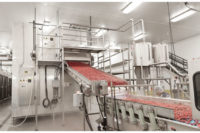For the frozen food processors, snow formation inside the individually-quick frozen (IQF) tunnel freezer represents an annual loss that over the years can double or even triple the capital cost of the equipment. But, how does snow form inside the IQF tunnel freezer, and how can manufacturers minimize it?
Snow formation inside the IQF tunnel freezer is directly linked to the process of product dehydration, a natural physical and chemical process that consists in water loss through the product’s cell walls when it makes contact with the cold air flow during freezing. Therefore, a dehydrated product weights less after being frozen.
So, what exactly is happening when snow is formed in an IQF freezer? As the relative humidity of the air in the tunnel is lower than 100%, it tends to extract the humidity from the product until it reaches the maximum point of moisture. When the air becomes 100% saturated, the process of snow formation begins. This natural phenomenon is known as precipitation, similar with rain or snow formation in the Earth’s atmosphere. As the snow is formed, the relative humidity falls again and the process re-starts. The main cause of snow formation inside the IQF tunnel freezer is the large quantity of warm and mostly wet product that interacts with the cold environment inside the freezer.
If snow formation inside the IQF tunnel freezer leads to product loss and dehydration, how can you avoid or at least minimize dehydration? To minimize dehydration, operators need to achieve an optimal airflow and right ratio between air speed and pressure inside the IQF tunnel freezer. This is the only to avoid the formation of snow crystals in the air. The right aerodynamics combined with the short freezing time ensure the lowest level of snow formation possible. It's the fine art to develop such a systemic balance, and there is still a lot of science to be done in order to completely eliminate dehydration from the freezing process.
Dehydration can be verified using several methods, like the weight of snow after a day of production, for example, or moisture measurement in the product before and after freezing.


